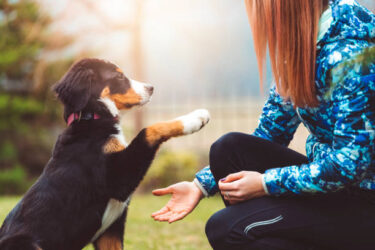Dogs can‘t speak, and many owners, especially novice owners, understand the dog‘s behavior according to their own ideas, causing a lot of misunderstandings. In fact, although dogs can‘t speak, their actions will directly reflect their mood, and dogs will not hide their feelings. Therefore, as a qualified dog owner, being able to read the dog‘s basic body language is one of the most important ways to understand the dog. There are also some owners who randomly guess the dog‘s psychological activities, resulting in misunderstanding of the dog‘s situation. This article briefly introduces the meaning behind your dog‘s body language/behavior.
Human-dog relationship
1. The dog lowers his upper body and sometimes growls. He is not really angry / wants to bite you / wants to fight or something. This action is very common in the world of dogs. It is a signal that the dog invites other dogs to play together. That is to say, when your dog makes this action, he wants to invite you to play with him quickly, not Aggressive. Since the dog has tried his best to invite you, it is better to play with him for a while. If the dog nibbles you after doing this, it‘s a further attempt to invite you to play, say no to the nibble, and if he doesn‘t, play with him for a while.
2. The dog wrinkled his nose and exposed his teeth was already warning “Don‘t come close, your actions make me very unhappy, and I will bite if you come close.Don‘t touch the dog, don‘t have the idea of ”Oh, the dog is angry, touch you and coax you to stop making trouble”. The first is easy to bite, and the second is a reward in the dog‘s world to be touched. If you touch him when he‘s grinning and ready to bite, you‘re rewarding him “Good baby is always ready to bite like this.If the dog sits on top of someone and grins at the other person as a warning, get the dog off the body immediately. Clearly marked no–waiting for calm–reward calm state, only three steps can be completed to be regarded as a correction.
3. The dog has obvious avoidance behavior. This is a dog with a better temper and a gentler way to tell you that he doesn‘t like what you are doing (touching him/kissing him/holding him, etc.) Some dogs are naturally timid and sensitive, as owners we ask dogs to show us respect At the same time, please respect the dog‘s feelings, and don‘t force him to accept what you think is intimate behavior. Especially with unfamiliar dogs, don‘t try to approach him if he has already shown an avoidance response.
4. The dog‘s frequent licking of lips/yawning/shortness of breath/stiffness indicates that he is nervous. Most likely it‘s the presence of someone/something/dog you‘re not familiar with, or someone doing something he doesn‘t like. Some dogs will bite because they are too nervous, so by the same token, if a certain behavior of yours makes the dog nervous, please don‘t continue. For aggressive dogs, this is a good precursor to aggression.
5. The dog raises one front foot/tightens the body/raises the tail, indicating that the dog is not sure. Usually judging that a certain smell in the air is deciding what to do next, or focusing on something is deciding what to do next. Basically the dog is carefully judging the current situation. For dogs with aggressive tendencies, the owner should be careful not to let the dog continue to focus too much on the person/dog in front of him at this time, which may lead to bad behavior. For a well-behaved and socially well-behaved dog, this action only requires the owner to wait patiently for the dog‘s decision.
6. The dog‘s head is lowered/behind the ears/the whites of the eyes can be seen in some cases/the body is as small as possible/the tail is drooping/the body is stiff, indicating that the dog is nervous and afraid. Some dogs act aggressively out of fear. * Note that at this time, if the aggressive dog owner touches him again, it will intensify the aggression, because touching him is equivalent to encouraging the dog‘s mentality of preparing for attack out of fear. The correct way is to remind the dog or take the dog away from the source of fear, and reward the calm state after the dog calms down. Never touch the dog/talk to him to try to comfort him when he is in a state of fear. he.
7. The dog‘s body is stiff/ears forward/tail is raised but does not move/eyes are staring straight ahead, indicating that the dog is completely attracted. The attention grabber could be other people/other dogs/moving critters/bugs/anything the dog looks suspicious. After the dog enters this state, the next step is likely to burst out. For aggressive dogs, once this state occurs, the next step is to attack. Therefore, the owner must pay attention to this state in the process of walking the dog, interrupt and correct it in time at this stage, and do not let the dog develop to the point of rushing out to bring the owner somersault, or fight with other dogs.

